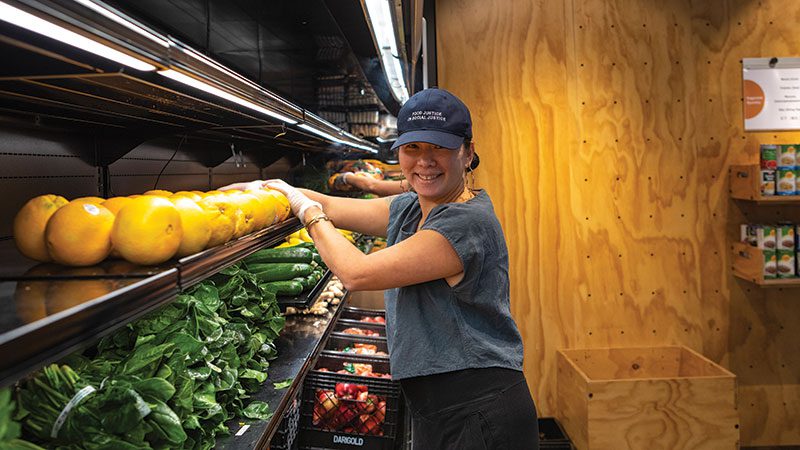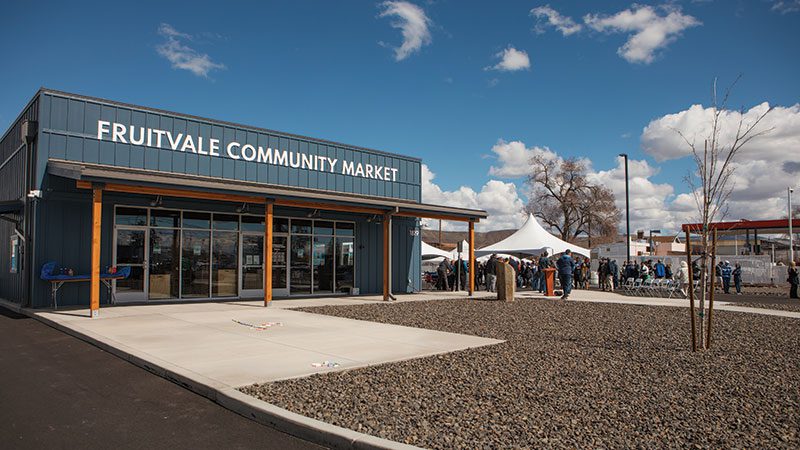Community Voices: A conversation with Northwest Harvest
Tara Austen Weaver
This article was originally published in November 2023

Community Voices: A conversation with Northwest Harvest
Photos courtesy of Northwest Harvest
PCC’s mission is to ensure that good food nourishes the communities it serves, while cultivating vibrant, local, organic food systems. We’re proud to partner with organizations throughout the region and share their stories.
Northwest Harvest, one of the region’s foundational hunger relief agencies, provides an average of 2 million meals each month through a statewide network of more than 400 food banks, meal programs, schools and community-based organizations. The nonprofit, focused on improving equity within our food system, specifies that as “part of a justice-centered movement, we advocate to change inequitable policies, practices and institutions that perpetuate hunger and poverty.” Northwest Harvest recently joined the Friends of PCC, a partnership that provides more choices and opportunities for area food banks to select food that meets their clients’ needs. PCC shoppers have generously supported this program through donations, and Northwest Harvest’s participation is expected to broaden the program’s reach and increase its purchasing power, helping more people access nutritious organic foods. Sound Consumer contributor Tara Austen Weaver recently spoke with Northwest Harvest’s community engagement director, Jeanie Chunn. A condensed, edited version of their conversation follows.
Q: What is the history of the organization? How did Northwest Harvest get started?
A: Northwest Harvest has always been a groundbreaking food justice organization. It started in 1967 (in response to the Boeing economic downturn). Some social justice activists got together and asked: How can we support our city, our communities? They opened one of the first food banks in the country.
In the mid-90s, there was a need to help getting food distributed. Northwest Harvest stepped into that gap as the first independent food distribution organization in the state. We distribute food to all 39 counties, working with smaller foodbanks.
In the 2000s, we realized there was a need for public policy support and advocacy to help legislators understand what is happening with food insecurity and what policies could best support people.
We also run two food banks—SODO Community Market, on 4th and Holgate, and we just opened one in Yakima called the Fruitvale Community Market. The one in SODO sees 200 to 300 people a day (open on Monday, Wednesday and Friday, only). The Fruitvale market sees 600 to 700 people a day (also M-W-F). Yakima is our agricultural heartland and it is one of the most food insecure counties in the state. We see a lot of farmworkers come through the Fruitvale market.
Q: Your food banks are a little different, can you tell us a bit about them?
A: It’s really important that we are centering a dignified shopping experience—there is so much stigma about going to food banks. Instead we call them “no-cost grocery stores.” We try to have a system where people just come in and pick up a grocery cart and they get to decide which apple or onion they want to take home with them. At the end, we bag up their groceries and they don’t pay.
Q: Can you share a bit about the values behind the organization?
A: We try to grow food justice through collective action. We lead with equity. We are trying to center the experience of those disproportionately affected—Black, Indigenous and people of color; it’s rural communities, queer communities, disabled communities. We center those experiences and get those voices in front of legislators, so they can understand what the need is and the barriers people are experiencing, so we can better serve our communities.
Q: If people want to get involved to help, how should they go about that?
A: Follow us on social media—that is a great way to hear about advocacy actions, when we need to reach out to legislators to support certain issues. People can donate on our website. We have a lot of members who donate a small amount each month; maybe they’ve been food insecure in the past and have relied on food banks. And we have larger donors who have resources, and we’re really grateful for that too.
You can also host your own food drive. Maybe you’re having a birthday party and instead of presents you could have people bring cases of beans or rice—and cooking oil is always in high demand. And volunteering your time. We have a real volunteer shortage right now. There’s been a 60% decline in volunteers at food banks since the pandemic. So, we’d really like to encourage people to get involved in their local hunger relief organizations. [A recent study by Feeding America showed that 51% of foodbanks nationally rely entirely on volunteer labor.]

Q: How does the distribution arm of Northwest Harvest work?
A: We distribute food to almost 400 food banks, community-based organizations and high-need schools. It gives us greater buying power when we’re able to purchase direct from farmers in larger quantities.
We have distribution centers in Auburn, Spokane and Yakima—and the one in Yakima is important. We intentionally built it larger than we need. There is a need in central Washington for more cold storage for small to mid-size producers, so we have plans for a social enterprise where we have a sliding scale model for farmers, who can use the storage to be able to bring all their produce to market. Yakima School District is our first customer.
Q: What is the current level of food insecurity and need right now?
A: It’s worse than it was during the pandemic (when) there were government subsidies put in place that were supporting families and others who are food insecure. Once the state of emergency was lifted in March and all of those programs went away, the floodgates opened. I recently spoke with one mother who had three children and she told me that her SNAP benefits [Supplemental Nutrition Assistance Program, sometimes referred to as food stamps] had been cut from $1,000 to $60 a month.
SNAP benefits are part of the Farm Bill, which is reauthorized every five years. So we have to make sure those benefits are protected—that is part of our advocacy work. Certain legislators are trying to add policies that would change benefit requirements and they are really affecting young people and seniors. We don’t live in a society that cares for our most vulnerable populations.
Q: What do you wish people understood about hunger relief?
A: Too often people think of a narrative that if these folks just worked harder and it’s their individual choices that are causing them to be hungry, and that’s just not true. We’re fighting the root systemic causes of food insecurity—poverty and racism and unlivable wages. These are systems of oppression.
How can we work on food insecurity in a way that we’re dismantling policies in order to support our community, so everyone has enough to eat? And once we are able to end hunger, we need to make sure those policies stay in place and are not disrupted or changed.
How to help
For more information on the organization or to get involved, please visit northwestharvest.org.
